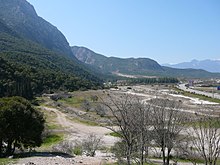Thermopylae
Coordinates: 38 ° 48 ′ 19 ″ N , 22 ° 33 ′ 46 ″ E
The Thermopylae ( ancient Greek Θερμοπύλαι Thermopylai , Latin Thermopylae ) were a bottleneck between the sea and the Kallidromos Mountains in central Greece (also Trachinic rocks ) with high strategic value in antiquity, as they represent the only way from the coast of the Malian Gulf to Inner Greece. Today the passage through silting is several kilometers wide.
Thermopylae owes its name to two hot springs ( ancient Greek Θερμοπύλαι Thermopýlai , plural, from θερμός thermós “hot” and πύλη pýlē “gate”, “opening”).
geology
Silting up
Due to the rise in sea level after the last ice age, the Gulf of Malia silted up more and more. The height of today's sea level has existed for about 6000 years, so silting took place in a geologically short time. As long as the sea level was a few meters lower, material was eroded rather than accumulated (see → river longitudinal profile and → landing ).
Several rivers, of which the Sperchios is the largest, flow into the gulf and form deltas . It is likely that human deforestation has accelerated the accumulation of material in the Gulf. These processes also exist in other places in the eastern Mediterranean, such as at the mouth of the Great Meander .
Hot Springs
As the name Thermopylae ( Hot Gates ) suggests, there are hot, sulphurous springs at this point. The springs are located east of the main road from Lamia to Athens, immediately behind a gas station and rest area. They are freely accessible. In addition to an artificially constructed waterfall, the warm water pours into a river bed, which was dammed for bathing right next to this waterfall.
According to various information in the literature, the water temperature of the exiting water is 40 to 42 ° C.
history

Herodotus reports that the passage was half a plethron (approx. 15 m) wide and that at the two narrowest points ( Alpenoi and Anthele ) there was only room for a carriage. That is why Thermopylae has always been the scene of important military maneuvers or major battles throughout Greek history.
Most famous is the First Battle of Thermopylae in 480 BC. During the Persian Wars . Furthermore, Callipus fought here in 279 BC. BC with 24,000 men against the Galatians . In 191 BC The Romans, under Manius Acilius Glabrio and the elder Cato, defeated the Seleucids Antiochus III in the Second Battle of Thermopylae . King Alaric I led the Visigoths through Thermopylae to Greece in 395.
At Thermopylae there is a monument designated as the grave of Leonidas . Leonidas, however, was buried in Sparta. Rather, it is a victory stele . The inscription reads:
"Ὦ ξεῖν ', ἀγγέλλειν Λακεδαιμονίοις ὅτι τῇδε κείμεθα, τοῖς κείνων ῥήμασι πειθόμενοι"
"Ō xeîn angéllein Lakedaimoníois hóti tēde keímetha toîs keínōn rhēmasi peithómenoi."
“ Wanderer, if you come to Sparta, proclaim there that you saw us lying here as the law ordered. "
The historical battle of 480 BC Today several monuments, including the Leonidas monument. The site is located east of the main road from Lamia to Athens, about 250 meters southeast of a petrol station and rest area, directly visible from the street.
From April 24 to 25, 1941, as part of the war in the Balkans, the Battle of Thermopylae took place between troops of the British Commonwealth and the German Wehrmacht .
Trivia
Several British ships were named after the English or Latin name of Thermopylae:
- Thermopylae , famous tea clipper (1868)
- Thermopylae , passenger and cargo ship (1891), stranded in 1899
- HMS Thermopylae , Royal Navy T-class submarine , in service 1945-1970.
Thermopylae is also the title of a painting by Oskar Kokoschka from 1954 .
literature
- JC Kraft: The Pass at Thermopylae, Greece. In: Journal of Field Archeology. Volume 14, 1987, ISSN 0093-4690 , pp. 181-198.
- Michael-Denis Higgins, Reynold-Alleyne Higgins: A Geological Companion to Greece and the Aegean. Cornell University Press, Ithaca / New York 1996, ISBN 0-8014-3337-1 , p. 81 ff.
- Mischa Meier : Thermopylae - "Hikers, are you coming to Spa (rta)". In: Karl-Joachim Hölkeskamp , Elke Stein-Hölkeskamp (ed.): Places of remembrance of antiquity. The Greek world. CH Beck, Munich 2010, ISBN 978-3-406-60496-6 , pp. 98-113.





